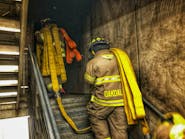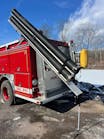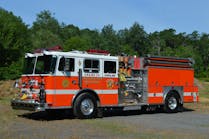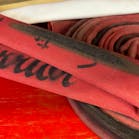Making the Push: The Foundations of a Flowing-While-Advancing Fire Attack - Part 2
In Part 1 of this series, we looked at several key study findings from a recent three-part UL study, “The Impact of Fire Attack Utilizing Interior and Exterior Streams on Firefighter Safety and Occupant Survival,”1 that support a flowing-while-advancing fire attack. Now, we examine proper hose handling, handline advancement and the importance of the backup firefighter.
Hose handling
The foundation of a flow-and-move fire attack lies within the nozzle firefighter’s ability to handle the hose. Flowing handlines should become second nature and, therefore, deeply engrained in muscle memory. It’s only through flowing thousands upon thousands of gallons of water that this can take place.
There are several mainstream grip techniques being taught today, and it is of great benefit to be well-versed in more than just a single style; one may become more situationally advantageous than another based on factors that are commonly encountered, such as stairs, turns, fire-attack staffing or even over-pumped lines.
Solid hose-handling technique is built around several common factors. The first is that the body’s largest muscles, the core and the legs, are taking the brunt of the nozzle reaction. While biceps/triceps and forearms will be engaged while gripping the line, they should not be left unsupported. The legs should also be “athletically positioned.” This means that the body is creating a wide base that is derived from strong triangles.
Next, a sufficient length of hose must be maintained in front of the firefighter. This increases the range of motion available and decreases the effort required for proper stream application. Finding the appropriate length of hose to keep out front is dependent on the hose and nozzle package selected. Every length of hose will respond differently to reaction forces, so minor adjustments must be made by the nozzle firefighter once water is flowing. What is constant is that the nozzle bail must always be within reach, and if a combination nozzle is being used, the ability to change patterns also should not be hindered. Once the line is open, the lead hand should also come underneath the hoseline so that the weight of the nozzle is supported. There should be a notable decrease in the occurrence of the hose kinking directly behind the nozzle when compared to placing the hand either on top of the hose or on leaving it on the nozzle bail.
Finally, the bail of the nozzle should be turned so that it is opened into the body. This means that if the line is on the firefighter’s right side, the bail should be positioned to the left side of the hose. Doing this will create the smoothest transition of the hand from the bail to the underside of the hose.
Hose handling should be initially be practiced and refined while the line is static. Introducing line advancement prior to establishing sound technique will lead to confusion, premature bail closures, and possibly losing hold of the hoseline. Positive habits and confidence in technique will be enforced by taking the time to build muscle memory without the added element of advancement.
Advancing Handlines
There is a distinct difference between simply flowing water and flowing water effectively. The end goal in flowing water is fire suppression, so applying water should not be done without a conscious effort to move the water where it is actually needed. In fact, failing to do so correctly can be counterproductive. Advancing past fire, dropping the thermal layering to the floor, and destroying any remaining visibility can all occur when too much focus is placed on moving with the line open and not enough thought is given to where the water is being applied. Sound technique and planned stream application, such as wall-ceiling-wall or clockwise “O’s,” can assist in effective water usage.
If, for whatever reason, effective water application is not being achieved, consider adjusting the game plan for moving while flowing. The first option is to stop the flow of water, quickly advance to the next point of attack, then resume fire suppression. Advancing without attempting to flow water does not require the same amount of coordination between crewmembers as moving while the bail is open, so effective water application may be reestablished quicker using this option. Fire conditions, however, will dictate whether it is even an option. Another option is to slow down the line advancement. The nozzle firefighter should be communicating to those backing him up on the line if the advancement is outpacing fire suppression. By slowing down, the nozzle firefighter should have the opportunity to regain his technique and ensure that the fire stream is reaching its intended target.
Strong communication and coordinated movements amongst company members must take place for a moving-while-flowing advancement to take place. The nozzle firefighter is the head and controls all the movements of the advance. The backup firefighter assists in countering the nozzle reaction force and ensures that the hoseline is progressing forward. The backup firefighter is set up next to, and in most cases, touching the nozzle firefighter. Ultimately, the backup firefighter will push the nozzle firefighter forward, when the nozzle firefighter indicates.
As the nozzle firefighter focuses on operating the line into the ceiling and walls, the backup stays low, driving forward. Staying low as a backup firefighter accomplishes several key things: It creates a stable and powerful base from which movements are built, it directs the force of the nozzle reaction into the body, and then into the ground, and, finally, it allows the nozzle to remain naturally pointed up. When turning corners, the nozzle firefighter and the backup firefighter need to turn in opposite directions, think of a tiller-truck, to help the line stay off the corner while keeping the hose straight into the nozzle fighter.
Often, a third, or even multiple, additional firefighters will be needed to keep the line moving. The number of additional members is directly correlated to building layout and the number of times the line must advance past a corner or other various obstacles. Within a stairwell, it is not uncommon to have up to six firefighters on a single handline. The gold standard would be to place one individual at every friction point. However, staffing limitations will often force a single firefighter to manage multiple, if not all, of the friction points. Advancement of the line will obviously be slower when this is the case. Do not hesitate to marry multiple companies together if the initial engine company is not capable of advancing the line without assistance. Backup hoselines and exposure lines should be deployed secondary to the primary attack line being advanced to the fire.
When considering companies with three-person staffing, a firefighter and an officer might be the only two individuals on a handline for a significant period of time. In these instances, the officer is the backup firefighter, and the positioning of the backup firefighter will usually change. Instead of being up with the nozzle firefighter, the backup will shift back on the line away from the nozzle to reduce drag in the working length of hose and to manage the hose around pinch points. This leaves the nozzle firefighter solely responsible for countering nozzle reaction. It is here that maintaining reasonable nozzle reaction forces in the attack package is most noticeable.
An attempt to advance the hoseline while flowing will immediately be hindered if sufficient slack hose has not been moved forward into the structure. It is the responsibility of the backup firefighter to ensure that this happens; similarly, it is the responsibility of the nozzle firefighter to communicate how much hose is going to be needed for the advance. There will likely be instances where the nozzle firefighter will need to hold their position to wait for the backup to bring hose forward. A length of hose equal to the expected distance that the nozzle firefighter will be traveling while flowing must be ready to move before advancement takes place. Aaron Fields of the Seattle Fire Department commonly preaches the practice of having the nozzle firefighter call out an estimated distance of travel prior to advancement, which will allow those firefighters tasked with bringing the line forward to know exactly how much hose will need to be managed throughout the stretch to the fire.
Excess hose can be staged in a variety of ways; this is often referred to as pre-loading. As open spaces in the interior are encountered, take advantage of the space and move excess hose into these areas. The line should be kept low to the ground to help avoid wrapping any objects with the hoseline. Creative use of open spaces includes using rooms opposite of the advance to stage slack, such as using an uninvolved apartment directly across from the fire occupancy. This is effective as it results in additional straight line behind the nozzle. Avoid staging hose in any space that would create additional pinch-points. In tight spaces, such as a hallway, build “S’s” in the line using the full width of the space. Forming loops or coils in the line is also effective, especially on small diameter hoselines; recognize that they also increase the potential for kinks, however.
Pre-loading hose also works vertically. In a stairwell stretch, hose can often be taken to the half-landing above the fire-floor prior to opening the door to the fire area. This allows gravity to assist in the advancement. It is possible to move a large loop of charged 1¾-inch hose up a stairway while staging at the base of the stairs as well; though it may take a short amount of time and effort to do so, it prevents a common misstep of halting progress while remaining on a flight of stairs.
Summary
Every engine company should set forth the goal of being able to advance a handline while flowing water, but intermediate steps must be taken before this type of attack can occur with any semblance of regularity. While physical ability and sheer grit go a long way in operating handlines, the truest form of efficiency is achieved by building an attack package that is advantageous to an interior fire attack. This includes determining realistic target flows and then creating an attack package that uses complimentary nozzles, hoselines, and deployment methods. Solid techniques in hose handling and hose movement must be instilled early. There is little point in trying to move forward with a flowing handline when there would be a struggle to flow while remaining static. Instruction is commonly given to those responsible for operating a nozzle, yet little effort is given toward instructing individuals on how to most effectively assist in the advance. The success of a flowing-while-moving fire attack is far more dependent on the efforts of the backup firefighter(s) than the one operating the nozzle. The benefits of flowing water while advancing are numerous. Keep that nozzle open while making the push.
References
1. Zevotek, R., Stakes, K., & Willi, J. Impact of Fire Attack Utilizing Interior and Exterior Streams on Firefighter Safety and Occupant Survival: Full Scale Experiments. UL FSRI. Retrieved from https://ulfirefightersafety.org/docs/DHS2013_Part_III_Full_Scale.pdf.
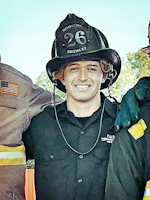
Jonathan Brumley | Firefighter
Jonathan Brumley is a firefighter with the Houston, TX, Fire Department. Beginning in 2009, his experience has spanned three states as both a paid and volunteer firefighter. He holds a bachelor of business administration degree in finance along with various fire service certifications. He recently presented at Firehouse World, authors The Fire Fight blog (the-fire-fight.blogspot.com) and serves as an adjunct fire instructor.

